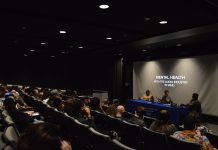
These morel mushrooms were hunted in northwest Missouri. Mid-April to mid-May typically marks the emergence of morels.
St. Louis native Don Dill, 88, began studying mushrooms 60 years ago. It started when he and some friends were at the Lake of the Ozarks. He went outside one morning to check their leaky boat tied in the water and was met with what looked like a flower garden. The area was covered with mushrooms.
“I never saw so many. They were all kinds, different colors and shapes,” Dill said. “Boy, I decided right then I wanted to know more about those things because they were so interesting.”
Dill, an original member of the Missouri Mycological Society, said it takes diligence to understand mushrooms and why they are where they are. He described mushrooms as a fascinating kingdom.
Webster Groves resident, Maxine Stone, a master gardener and Missouri master naturalist, is a past president of the Missouri Mycological Society. The society works to educate its members and the public about mushrooms and mushroom hunting. She authored “Missouri’s Wild Mushrooms,” published by the Missouri Department of Conservation in 2010. It details 102 of Missouri’s common mushrooms.
“When you get something in abundance, it is not as rare, it’s not as important, and it’s not as valued,” Stone said. “But, when you can get something that isn’t in abundance, it’s really valued and something very special. There is an excitement when you find (morels), and besides that, they taste great … people just love them.”
Missouri Department of Conservation Agent in Lincoln County Kevin Eulinger has hunted mushrooms for 25 years. He said mid-April to mid-May is the general time frame to start looking for morels.
“One thing I’ve always kind of lived by is the average of the daily high and daily lows,” Eulinger said. “When that reaches about 60 degrees for the average of the high and low, that is a good recipe for when mushrooms will start to emerge.”
There are different strategies for hunting morels. Eulinger said there are specific habitat areas for finding morels: dead or dying elm trees, recently burned

Maxine Stone holds a Grifola frondosa or Hen of the Woods mushroom. Stone is a Webster Groves resident and past president of the Missouri Mycological Society.
areas, maple groves and orchards. Once a person identifies the many different elements which point to where morels like to grow, they can begin to look for those situations to help narrow their search.
Stone said she believes in ethical harvesting — that a person should try and leave things in nature the way they found them as much as possible. When harvesting, she said hunters should use mesh bags or baskets in order for spores to fall off the mushroom and be released back into nature. Mushrooms should be pinched or cut, and anything that goes into the earth should be left behind.
Eulinger said the organisms that produce mushrooms are underground. The mushroom element people pick and eat are the fruit the organisms produce, similar to apples from an apple tree.
“It is such an environmental response to generate a lot of mushrooms. One particular place I’ll go every year — sometimes I’ll find just a few and sometimes I’ll find a lot,” Eulinger said. “It’s all environmental. It’s all about temperature and water. If those two things are just right, it can be really, really good.”
If a fertile spot is discovered, “hunters” return year after year and collect the coveted prizes. A few mushrooms that grow in Missouri can be poisonous, a risk that can keep many people from going mushroom hunting at all.
Eulinger said morels are one of the easier mushrooms to identify. Still, he always encourages the novice mushroom hunter to go with someone who has experience. He said it is important to be cautious of mushrooms that could make you sick or could even be fatal in certain situations.
The Missouri Department of Conservation has online and printed materials to help identify edible and non-edible mushrooms. Eulinger recommends using a guide that is specific to Missouri mushrooms.
“There is an old saying amongst mushroom hunters: ‘There are old mushroom hunters, and there are bold mushroom hunters, but there are no old bold mushroom hunters,’” Eulinger said. “If you get too brave, and you try something you are not supposed to, you may not be around very long.”
If a person does not have access to private property, there are public areas that provide good opportunities for mushroom hunting. Conservation areas and U.S. Army Corps of Engineers land are among many areas normally open to the public. Areas include the Weldon Springs Conservation area along the Missouri River and the August A. Busch Memorial Conservation area.
Eulinger said it is always a good idea to check the rules and regulations of an area. Nature centers, such as Powder Valley Conservation Nature Center, is an example of a place where a person generally cannot hunt for mushrooms.





[…] Shorter version published in Webster University’s The Journal. https://ive.90c.myftpupload.com/2014/04/08/warm-weather-ushers-in-mushroom-season/ […]
Comments are closed.